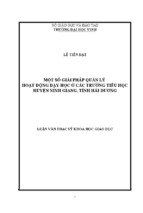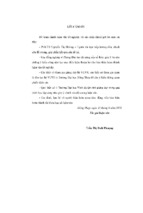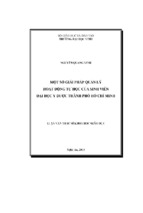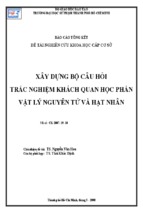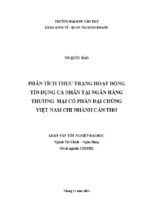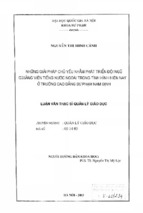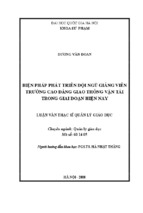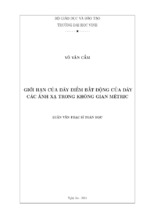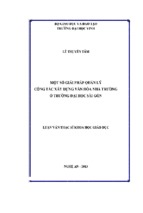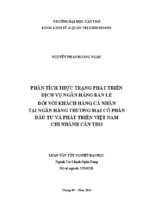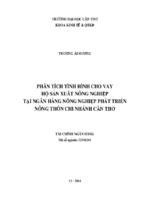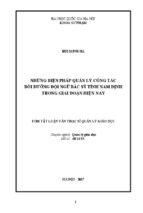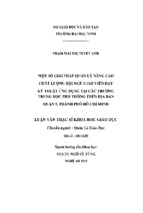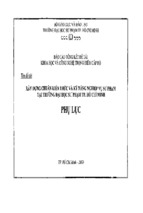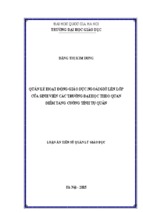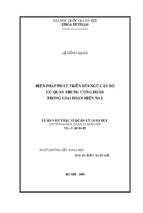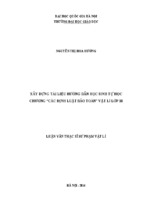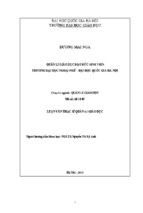Tài liu lun vn s phm , giáo dc1 of 63.
HANOI PEDAGOGICAL UNIVERSITY 2
FACULTY OF FOREIGN LANGUAGE
NGUYEN MINH PHUONG
A STUDY ON COMMON GRAMMATICAL ERRORS IN
SPEAKING SKILL OF 11th GRADE STUDENTS
AT A HIGH SCHOOL IN VIETNAM
(NGHIÊN CỨU VỀ LỖI NGỮ PHÁP PHỔ BIẾN TRONG KĨ NĂNG NÓI CỦA
HỌC SINH KHỐI 11 TẠI MỘT TRƯỜNG CẤP 3, VIỆT NAM)
(Graduation paper submitted in partial fulfillment of the Degree of Bachelor of
Arts in English)
Major: English Language Teaching Method
Hanoi, 2019
Footer Page 1 of 63.
Tài liu lun vn s phm , giáo dc2 of 63.
HANOI PEDAGOGICAL UNIVERSITY 2
FACULTY OF FOREIGN LANGUAGES
NGUYEN MINH PHUONG
A STUDY ON COMMON GRAMMATICAL ERRORS IN SPEAKING
SKILL OF 11th GRADE STUDENTS AT A HIGH SCHOOL IN VIETNAM
(NGHIÊN CỨU VỀ LỖI NGỮ PHÁP PHỔ BIẾN TRONG KĨ NĂNG NÓI CỦA
HỌC SINH KHỐI 11 TẠI MỘT TRƯỜNG CẤP 3, VIỆT NAM)
Major: English Language Teaching Method
SUPERVISOR: TRẦN THỊ MINH PHƯƠNG, MA.
Hanoi, 2019
Footer Page 2 of 63.
Tài liu lun vn s phm , giáo dc3 of 63.
ACKNOWLEDGEMENTS
I would like to express my many thanks to people who have supported me to
complete the research.
To my supervisor Tran Thi Minh Phuong, who directly instructed, encouraged and
gave me many valuable ideas. I am extremely grateful for her extensive knowledge as
well as her enthusiasm, which are of almost significant to the achievement of my
research.
I would like to convey my thanks to all English teachers of Yen Khanh A High
school who have assisted me with lots of useful suggestions and provided with rich and
detail data for the study.
Also, I wish to express my gratitude to all students from 3 classes: 11D, 11E, 11G at
Yen Khanh A High school for their participation, enthusiasm, cooperation during the
time I surveyed.
I owe a special note of gratitude to English teachers of Ha Noi pedagogical
University II, who have enthusiastically taught and conveyed their experiences during
the time I started to carry the research.
Finally, I would like to thank to my family, friends and relatives, who have always
paid attention, encouraged me and supported me throughout the process of studying,
conducting and completing the topic.
i
Footer Page 3 of 63.
Tài liu lun vn s phm , giáo dc4 of 63.
ABSTRACT
This paper studied on common grammatical errors in speaking skill of 11th grade
students at Yen Khanh A High school. In the research, the author combined the use of
quantitative and qualitative methods to achieve the desired results. The participants of
the study is a hundred and twenty students of the 11th grade and ten English teachers at
Yen Khanh A High school.
Research results illustrates that most of the 11th grade students in Yen Khanh A High
school suffer from errors related verb form, prepositions, articles, subject-verb
agreement as well. Besides, from teacher's point of view at Yen Khanh A High school,
the main cause of these errors is the direct impact on students 'psychology; the students'
grammatical knowledge is not really deep; the influence of Vietnamese grammar while
speaking. Specially, they strongly emphasize on performance pressure factor, which is
the most common ones. In order to minimize these errors, teachers should apply
suitable and flexible techniques and create opportunities for students to talk as much as
possible. Meanwhile, students should communicate regularly with teachers and friends,
as well as having suitable methods for self-study.
Key words: grammatical errors, speaking skill, 11th grade, Yen Khanh A High School.
ii
Footer Page 4 of 63.
Tài liu lun vn s phm , giáo dc5 of 63.
STATEMENT OF AUTHORSHIP
Title: A study on grammatical errors in speaking skill of the11th grade students at a
high school in Vietnam.
I certify that no part of this research has been copied or reproduced by me from any
other person‘s work without the proper acknowledgement. And the results are my own
research, all data are collected from the process of survey and data processing,
absolutely no data duplication or fabrication.
Date submitted:
Student
Supervisor
iii
Footer Page 5 of 63.
Tài liu lun vn s phm , giáo dc6 of 63.
LIST OF TABLES
Table1: Common prepositions according to Langen ....................................................16
Table 2: Tenses and Structures of tenses according to Quirk(2010) ...........................22
Table 3: Compare the present perfect tense and the simple past tense ........................24
Table 4: Types of tenses ....................................................................................................25
Table 5: Frequency of errors based on linguistic description ......................................34
Table 6: Level of student’ errors based on teacher’s views...........................................41
iv
Footer Page 6 of 63.
Tài liu lun vn s phm , giáo dc7 of 63.
LIST OF FIGURES
Figure1: The role of speaking skill..................................................................................37
Figure 2: Students‘ interest in English grammar ..........................................................38
Figure 3: The role of grammar in speaking skill ...........................................................39
Figure 4: Causes of errors ................................................................................................42
v
Footer Page 7 of 63.
Tài liu lun vn s phm , giáo dc8 of 63.
TABLE CONTENT
PART A: INTRODUCTION ................................................................................................... 1
I.Rationale of the study .............................................................................................................. 1
II.The significance of the study ........................................................................................ 4
III.Aims of the study ................................................................................................................... 4
IV.Research question .................................................................................................................. 4
V.Scope of the study .................................................................................................................... 4
VI.Method of study ..................................................................................................................... 5
`VII.Main contents....................................................................................................................... 5
PART B: DEVELOPMENT .................................................................................................... 6
CHAPTER I: LITERATURE REVIEW ............................................................................. 6
1.Literature review in brief…………………………………………………………………..6
2.Theories of Speaking ............................................................................................................... 7
2.1.Definition of speaking .......................................................................................................... 7
3.Theories of Grammar ............................................................................................................. 9
3.1.Definition of grammar ......................................................................................................... 9
3.2.Roles of grammar in speaking .......................................................................................... 9
4.Theories of Error .................................................................................................................... 10
4.1.Definitions of Error ............................................................................................................ 10
4.2.Types of error……………………………………………………………………………...11
5.Theories of Error analysis ................................................................................................... 13
5.1.Definition of Error analysis ............................................................................................ 13
5.2.Significance of error analysis .......................................................................................... 14
6.Theories of Grammatical error.......................................................................................... 14
6.1.Definition of Grammatical error ................................................................................... 14
6.2.Grammatical errors classification ................................................................................. 15
CHAPTER 2: METHODOLOGY ....................................................................................... 29
2.Participants .............................................................................................................................. 29
3.1.Observation ........................................................................................................................... 30
vi
Footer Page 8 of 63.
Tài liu lun vn s phm , giáo dc9 of 63.
3.1.1.Reasons for using observation ..................................................................................... 30
3.1.2.Description of class observation .................................................................................. 30
3.2.Survey questionnaires ........................................................................................................ 30
3.2.1.Reasons for using Questionnaire ................................................................................ 30
3.2.2.Description of questionnaire ........................................................................................ 31
3.3.Recording............................................................................................................................... 31
3.3.1. Reasons for recording ................................................................................................... 31
3.3.2. Description of recording ............................................................................................... 31
CHAPTER 3: FINDINGS AND DISCUSSION .............................................................. 33
1.Findings and discussion ........................................................................................................ 33
1.1. Data analysis of observation and recording .............................................................. 33
1.2 Data analysis of the survey questionnaire ................................................................... 36
2. Suggested solution ................................................................................................................. 44
2.1. Suggested solutions ........................................................................................................... 44
PART III.CONCUSION ......................................................................................................... 47
1.Summary of the study ........................................................................................................... 47
2.Limitations of the study ........................................................................................................ 48
3.Suggestions for further studies ........................................................................................... 48
4.Recommendations .................................................................................................................. 49
REFERENCE ............................................................................................................................. 51
APPENDICES ............................................................................................................................ 54
vii
Footer Page 9 of 63.
Tài liu lun vn s phm , giáo dc10 of 63.
PART A: INTRODUCTION
I.Rationale of the study
As we all know, language plays a very important role in human life, which is the
characteristic of human. In daily life, we use language to communicate, also to
exchange cultural, economic, political expansion and cooperation in many other
aspects of life. For international communication, English is used as a bridge between
different nations, which is spoken by most countries in the world, including Viet Nam.
Therefore, we can not deny the importance of this international language in today's
society.
In fact, enhancing learner‘s communicative capability is one of the main goal of
teaching and learning foreign language. However, to master a new language is not
simple, it requires us to learn all four skills: listening, speaking, reading and writing. In
those skills, speaking requires learners to practice regularly and have their own
strategies. Besides, a good speaker needs to have good interaction with listeners,
fluency and speed of utterance. Most students find it difficult to speak English at first.
Speaking, however, in view of Competence Based Curriculum speaking is one of the
four fundamental abilities that the students should gain well. It has an essential job in
communication. Speaking can discover in spoken cycle particularly in Joint
Construction of Text arrange (Departmen Pendidikan Nasional, 2004). In other word,
speaking is considered as the most important skill for the purpose of communication
and one of the key helping learners easily conquer this interesting language.
Like writing skill, speaking is production skill. If when writing, learners have time to
think, also correct grammatical structures, then spoken English is uniquely
spontaneous, unplanned and produced in real time with no opportunity for editing
(Cullen and Kuo 2007), Obviously, when speaking English, learners do not have time
to think, but must deal quickly with their instincts.
According to Azar (2007), Grammar can ―help students discover the nature of
language, i.e., that language consists of predictable patterns that make what we say,
read, hear, and write intelligible‖ . It means that without grammar, people would have
only individual words or sounds, pictures, and body language to communicate
1
Footer Page 10 of 63.
Tài liu lun vn s phm , giáo dc11 of 63.
meaning. Brumfit (1984) as well refers to the accuracy of the language content:
grammar, pronunciation and vocabulary.
Also, in any language, grammar makes significant contribution to speaking skill. This
implies linguistic use this rules can offer assistance learners think logically, clearly and
accuracy when speaking. The fact that each person has a different perspective on
teaching and learning grammar. For those who are just beginning to learn English or
have a short-term goal in this subject, grammar may not be important. Sellers or drivers
still could speak English simply for sales. They only need to grasp basic vocabulary
related to the item and the price is enough for customers to listen and understand
without much grammar. However, when passing the first stage of learning English,
people focused more on accuracy. It is clear that when evaluating someone's speaking
ability, we cannot ignore grammar factor. According to Mr Nguyen Xuan Quang (the
co-founder and trainer of English pronunciation at Moon ESL) it is extremely difficult
to assess students through their pronunciation. If focusing on pronunciation only
instead of grammar will put great challenges for the whole system: how to evaluate?
In addition, using the right grammar when speaking also shows respect of speakers to
the listeners. Obviously, when you are good at grammar, you will hear and understand
others more easily. Without grammar, you will not be able to understand or
misunderstand the meaning of the speaker. Compare the two following sentences:
- I am in love with Tien Dung.
- I was in love with Tien Dung.
The difference is unremarkable (am - was), but the relationship between the speaker
and "Tien Dung" is very different in two cases.
Or another example, the listener may misunderstand the meaning of the speaker
- Can you take me a pen on my bag ?
-OK….I can’t see it. On where?
-On my bag, oh I’m sorry in my bag.
As you can see in the above case, the speaker asks to mistake the position of the pen
due to misusing preposition on and in, so the listener misunderstand his meaning and
can not find the pen at first.
2
Footer Page 11 of 63.
Tài liu lun vn s phm , giáo dc12 of 63.
In the past, when Vietnam had not yet renovated its teaching program, teachers
mainly used traditional methods: reading and translating. When teaching English, most
schools focus strongly on the grammar on the written but lack emphasis on speech.
What‘s more, teachers almost control students during class time. In this situation, Viet
Nam‘s education sector today has been renewed, focusing on developing all four skills:
listening, speaking, reading and writing.
Nevertheless, one of the biggest barrier facing Vietnamese students is the lack of
experience. Particularly, most of time students are taught hundreds of grammar rules
but it‘s almost impossible for them to apply these grammar rules accurately and
effectively to speaking skill. Besides, the time spent on practice speaking is too little
for students. Especially, a notable situation is that students learn just for points, the
form of examinations or tests based on reading and writing skill only. Therefore,
students do not seem to focus on speaking skill much, which leads to deviations in
learning English: understand but not applicable. Dr. Nguyen Thi Hao (Deputy Head of
Education Management Department, University of Social Sciences and Humanities,
HCM) supposed that many students until the 12th grade, when meeting tourists, cannot
guide them by using simple directions structures.
Regardless of the changes which should be made in concentrates on grammatical
errors in spoken language, such research would fill an instructive need by indicating
what students have realized and what they have not yet achieved in speaking English.
Such study also would contribute to writing on linguistic properties of spoken language
for materials improvement. Hence, with a reason above, there arises a need of a
research on ―A study on grammatical errors in speaking skill of the11th grade students
at a high school in Vietnam”
II. The significance of the study
Making mistakes in speaking is unavoidable, and it is also as one of the underresearched issues in speaking skill for students in Vietnam. Hopefully, this research
will be helpful for students, teachers and as well as researchers in the related fields:
3
Footer Page 12 of 63.
Tài liu lun vn s phm , giáo dc13 of 63.
Firstly, for students, this study can help them recognize some common types of
grammatical errors in speaking and employ effective learning methods in studying
English speaking skill.
Moreover, it will be very useful for teachers in teaching speaking skill since they can
understand the common mistakes of students.
Last but not least, this paper may be laid foundation for researchers to find out more
about their related areas.
III.Aims of the study
The minor purpose of the study focuses on investigating some common grammatical
errors in speaking skill by students of grade 11 at Yen Khanh A High School. Also,
the reasons that students often make grammatical errors when speaking and then
suggest some solutions for teachers could find out the common mistakes students
make.
IV. Research question
As the aims mentioned above, the researcher contains the research question as
follows:
1. What are the common grammatical errors committed by 11th grade students at Yen
Khanh A school?
V. Scope of the study
Grammar is considered as important and difficult aspect in speaking. However,
because of the limited time and the restricted experience, I just concentrate on
analyzing a number of common students‘ grammatical mistakes in speaking skill.
Hopefully, this graduation paper is able to provide teachers good and useful
information about students‘ common mistakes when they speak, so teachers can make
relevant change and adaptation to tackle this problem. Furthermore, this study
discovers the attitude of students towards speaking English, especially is grammar in
speaking skill.
VI.Method of study
One hundred and twenty students of grade 11 at Yen Khanh A high school were
chosen as subjects of the study. They were both male and female between 17 and 18
4
Footer Page 13 of 63.
Tài liu lun vn s phm , giáo dc14 of 63.
years. All of them have been learning English as a compulsory subject at school for at
least six years. In this thesis proposal, there were three tools used as effective ways to
evaluate the results of the thesis: observation, questionnaire and recording. Observation
and recording were proceeded in the first five weeks with a view to taking note
speeches of students. I observed the whole class and recorded 5 to 6 students ‗speeches
each time. The questionnaires were used in the final week by Yen Khanh A‘s students
and the assistance of some English teachers at Yen Khanh A High School to investigate
the real situation of speaking proficiency of 11th grade students at Yen Khanh A High
School.
VII.Main contents
Part A, Introduction, offers an overview of Rationale, Aims of the study, Research
questions, Scope of the study, Methods of the study and Significance of the study.
Part B, Development, gives information on Literature Review, Methodology, Finding
and Discussion, Implications of the study.
Chapter I, Literature review, presents language acquisition, theoretical frameworks of
language learning factors and research framework.
Chapter II, Methodology, describes in detail the Participants, Research instruments
employed and Procedure of data collection analysis.
Chapter III, Findings and discussion, analyzes gathered data and presents the
discussion of research findings. And then give suggested solution for teachers.
Part C, Conclusion, summary of the study, limitations and suggestion for further study.
5
Footer Page 14 of 63.
Tài liu lun vn s phm , giáo dc15 of 63.
PART B: DEVELOPMENT
CHAPTER I: LITERATURE REVIEW
1.LITERATURE IN BRIEF
Studying on grammatical errors when speaking is always a topic that attracted many
previous researchers, including Clark and Clark (1977), Ellis (1997), Burt and Krashen
(1982) and so on. They all have different ways of analyzing and classifying errors. In
general, they stated that speech error and error analysis are closely related.
In August 2016, Safrida, Usman Kasim conducted a research on "Grammatical
Errors: An Analysis in Speaking Produced by EFL Undergraduate" taken on the third
semester students of Syiah Kuala University on their speaking in Indonesia. The
researcher gave a speaking test to the eight of the third semester English Education
students of Syiah Kuala University. He used convenience sampling technique to limit
the subject chosen. The writer asked students to talk about their most memorable
experience within 5 to 8 minutes. Next he recorded the students' speeches. He also
asked extensive questions related to the recording topics to gather more data. Then, the
data, which had been recorded were transcribed and analyzed in several steps. The
findings showed that the most dominant errors that students produced were in
omission. In this research, the students mostly neglected the past forms of both regular
and irregular verbs. On the other hand, the smallest occurrences of errors were in
misordering.
Besides, Merlyn Simbolon studied ―An Analysis of Grammatical Errors on Speaking
Activities” (September 2015) .The number of the research subject was 30 students of
the second year students of English Education Department, Palangka Raya University.
Qualitative research is the method used in this study. The errors were indentified and
classified according to Linguistic Category Taxonomy and Richard‘s classification.
The result indicated that the errors made by students were in 6 aspects; errors in
production of verb groups, errors in the distribution of verb groups, errors in the use of
article, errors in the use of preposition, errors in the use of questions and miscellaneous
errors.
6
Footer Page 15 of 63.
Tài liu lun vn s phm , giáo dc16 of 63.
Furthermore, Hervina also analyzed grammatical errors when speaking with title
"Grammatical error in speaking made by the third year English Department students
at STKIP Abdi Pendidikan Payakumbuh "performed on 3rd year students of STKIP
Abdi Pendidikan Payakumbuh, published in 2014. The researcher used the qualitative
method, including: observation, interview and documentation. The writer used 3
activities on data analysis: data reduction, data display, drawing/verification. The
results illustrated that most students could not master the use of verb groups. They also
confused in making the agreement between subject and verb. In addition, prepositions
were one of the obstacles for students when speaking English.
In brief, each of type of error has source of error. Depending on different contexts as
well as different conditions, learners may make different grammatical errors. Thus, it is
essential to have a study on common grammatical errors in speaking English of
students at Yen Khanh A High School.
2.Theories of Speaking
2.1.Definition of speaking
Oxford dictionaries defied speaking is the action of conveying information or
expressing one's feelings in speech or the activity of delivering speeches.
According to Burns & Joyce, 1997, speaking is stated as an intelligent procedure of
developing implying that includes delivering, getting and handling information. Its
form and meaning is based on different factors in different contexts such as
participants, including speakers and listeners, physical environment and goals for
speaking. As Hybel (2001) declared that speaking is any procedure in which
individuals share information, thoughts, and feeling, it includes all of non-verbal
communication and style whatever adds significance to a message. Specially, speaking
is to express our thought to others in oral communication, additionally a handle in
which a speaker passes on data or messages to listeners.
Furthermore, it is generally believed that speaking skill is one of the important skills
that must be mastered by a language learner (according to Goh & Burn, 2012). Indeed,
to become a good language learner, we cannot ignore speaking skill because it is the
7
Footer Page 16 of 63.
Tài liu lun vn s phm , giáo dc17 of 63.
main part of communication, which can affect others‘life. Also, Thornbury (2005)
stated that speaking is a speech production that becomes a part of our daily activities.
He said that many people produce many words every day in order to express their idea
and feeling. Obviously, speaking is an essential part of human life, it appears in all our
activities. When we want to ask a question, or express our opinions, we all have to
speak.
The spoken language also has its own rules or structures, which are different from the
written language. (Burns & Joyce, 1997; Carter & McCarthy, 1995; Cohen, 1996). For
example we can freely use slangs or idioms during speaking or communicating without
boring, but in writing, we are not encouraged to use them regularly, even restrictively.
Also, while we use mostly active sentences in speaking to ensure nature: Most people
love Quang Hai, we use passive sentences more often in writing: Quang Hai is loved
by most people
As Tarigan (1990) speaking is a language ability that is created in child life, which is
delivered by listening skill, and at that period speaking skill is found out. He also
highlighted that in communication, speaking is also a way to strongly reflect our lives.
Wilson (1983) defines speaking as the relationship between speaker and listener in
communication. The principle target of speaking is for communication. So as to
express adequately, the speaker should know precisely what he/she needs to speak or to
communicate, he/she must probably assess the impacts of his/her communication to
his/her listener, he/she needs to see any rule that based his speaking either in general or
in individual.
To sum up, speaking is the production skill where we use words to produce
meaningful messages to convey thoughts and feelings to the participants of the
conversation.
8
Footer Page 17 of 63.
Tài liu lun vn s phm , giáo dc18 of 63.
3.Theories of Grammar
3.1.Definition of grammar
Grammar is the whole system and structure of a language or of languages in general,
usually taken as consisting of syntax and morphology (including inflections) and
sometimes also phonology and semantics.
(www.oxforddictionaries.com)
Grammar is the system of a language. Sometimes it is described as the "rules" of a
language; but in fact no language has rules.
Different experts define the term grammar differently and there is no fixed definition of
grammar. Harmer (2004) defined grammar as the description of the ways in which
words can change their forms and can be combined into sentence in that language. As
him stated in communication, it was rules or regulations when building a language and
using that language. Besides, Ur mentioned grammar as the manner in which language
controls and consolidate words or bits of words so as to frame longer units of
implications.
Grammar is the foundation of our own ability. The more we grasp how it works, the
more progress we have and the mastery of that language. It can help encourage
exactness, distinguish equivocalness, and endeavor the lavishness of articulation
accessible in English. What's more, it can support everybody, instructors of English,
yet educators of anything, for all instructing is eventually a matter of getting to grasps
with significance
(David Crystal, ―In World and Deed‖, TES Teacher, April 30, 2004).
3.2.Roles of grammar in speaking
Grammar plays a very important and diverse role, especially in everyday
communication. The role of grammar can take many dimensions and varies according
to the situation and context in which it is used (according to Zakaria Dalil, June 2013)
.One of the upper most traits of grammar is that it enables learners to make correct
sentences, be they spoken or written.
9
Footer Page 18 of 63.
Tài liu lun vn s phm , giáo dc19 of 63.
―We know that the strength of a tree lies in its roots. Similarly the strength of any
spoken language lies in its grammar.‖
(Blog, how to improve spoken English) .
It means grammar is the foundation when learning a foreign language.
Also, Marcel (1853) focused the significant role of grammar on his book that
grammar forms for us the habit of correctness of language, while helping us to think
more logically, more orderly and more clearly.
Moreover, a proper use of grammar is a sign of respect, both for speakers and
listeners (Clack, 2010). It means that ―A person with a poor grammar skill can form
negative impression on the first time meeting and this may last for a long time‖
( https://www.ukessays.com/essays)
Besides, it helps learners to discover the true nature of language, other skills such as
listening, speaking, reading and writing thus also become easier to understand. Without
grammar, we will only have words, images, sounds and individual body expressions to
convey information. Grammar is the weaving that creates the fabric (Betty Azar,
2007).
Additionally, Swan (1998) held believe that knowing how to build and use certain
structures makes communication possible. Without the connection between these
structures, even simple sentences become very confusing. In fact that, correctly
understanding English structures, we can communicate much more fluently. He also
asserted that in some social contexts, the wrongness of the speaker's use of grammar
can lose the integration and arousing prejudice, a poor speaker may be considered
disrespectful or uneducated.
4.Theories of Error
4.1.Definitions of Error
According to collins dictionary An error is something you have done which is
considered to be incorrect or wrong, or which should not have been done.
Different researchers defined different views. J. Richard et al (2002) described the
error may be the wrong way to use a word, speech act or a grammatical structure in
such a way it seems imperfect and significant of an incomplete learning.
10
Footer Page 19 of 63.
Tài liu lun vn s phm , giáo dc20 of 63.
Meanwhile, Norrish (1983, p.7) considered errors occur according to a system,
learners may not understand or understand but apply wrongly when practicing. This is
really problematic because if it is not edited from the beginning, it can become a habit
and very difficult to overcome later.
As James (1998) considered
an
error
as grammatical correctness and
acceptance. He judges errors according to ignorance, it is the research on linguistic
ignorance, surveys about those mistakes and how people face such ignorance. He
stated that the ignorance of learners of the target language can be shown following as
four categories: grammaticality, acceptability, correctness and strangeness
and
infelicity.
Hendrickson (1987) cited that errors are ‗signal‘ that indicate an actual learning
process taking place and that the learner has not yet mastered or shown a wellstructured competence in the target language. In other word, the error is a signal that
the learning process of the learner is having problems, which may be due to the lack of
professionalism or the ability of the learner to target the language.
It is declared by Brown (2007, p.258) that error as noticeable derivation from the
grammar of a native speaker, reflects the competence of the learner and reveals a
portion of learners‘ competence in the target language. Errors are factors to reflect
learners' qualifications and attitudes towards the purpose of language learning.
Moreover,
Ellis (1997, p.17)
revealed
errors
reflect holes in a students'
information; they happen on the grounds that the student does not realize what is
correct. The fact is that learners make mistakes but they are not aware, this is
because the learner's knowledge is not deep enough to realize and correct for
themselves.
4.2.Types of error
There are several ways to classify errors, and researchers categorize them in different
ways.
On the point of Richards (1974) classified errors into two categories according to their
causes, which are as follows: Interlingual errors-these errors occur due to mother
tongue .And intralingual and developmental errors-this kind errors are caused
11
Footer Page 20 of 63.
- Xem thêm -

